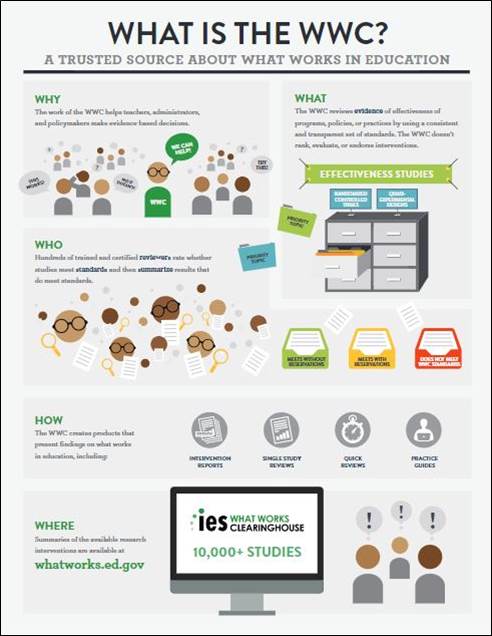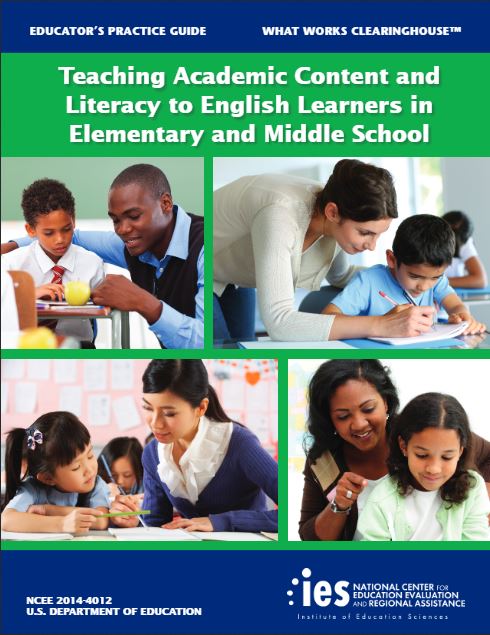By Diana McCallum, Education Research Analyst, What Works Clearinghouse

It’s been more than a decade since the first What Works Clearinghouse reports were released and we have a wealth of information and resources that can help educators and leaders make evidence-based decisions about teaching and learning. Since 2005, the WWC has assessed more than 11,500 education studies using rigorous standards and has published hundreds of resources and guides across many content areas. (View the full version of the graphic to the right.)
The WWC website has already received more than 1.7 million page views this year, but if you haven’t visited whatworks.ed.gov lately, here are five reasons you might want to click over:
1) We are always adding new and updated reviews. Multiple claims about programs that work can be overwhelming and people often lack time to sift through piles of research. That’s where the WWC comes in. We provide an independent, objective assessment of education research. For example, we have intervention reports that provide summaries of all of the existing research on a given program or practice that educators can use to help inform their choices. In addition, when a new education study grabs headlines, the WWC develops a quick review that provides our take on the evidence presented to let you know whether the study is credible. In 2015, we added 43 publications to WWC and we’re adding more every month this year.
2) We’ve expanded our reach into the Postsecondary area. In late 2012, the WWC expanded its focus to include reviews of studies within the Postsecondary area to capture the emerging research on studies on a range of topics, from the transition to college to those that focus on postsecondary success. To date, the WWC has reviewed over 200 studies on postsecondary programs and interventions, and this area continues grow rapidly. In fact, several Office of Postsecondary Education grant competitions add competitive priority preference points for applicants that submit studies that meet WWC standards. (Keep an eye out for a blog post on the postsecondary topic coming soon!)
3) You can find what works using our online tool. Wondering how to get started with so many resources at your fingertips? Find What Works lets you do a quick comparison of interventions for different subjects, grades, and student populations. Want to know more about a specific intervention? We’ve produced more than 400 intervention reports to provide you the evidence about a curriculum, program, software product, or other intervention for your classroom before you choose it. Recently, we’ve added a feature that allows a user to search for interventions that have worked for different populations of students and in different geographic locations. As we mentioned in a recent blog post, the Find What Works tool is undergoing an even bigger transformation this September, so keep visiting!

4) We identify evidence-based practices to use in the classroom. The WWC has produced 19 practice guides that feature practical recommendations and instructional tips to help educators address common challenges. Practice guides (now available for download as ebooks) provide quick, actionable guidance for educators that are supported by evidence and expert knowledge within key areas. Some of our guides now feature accompanying videos and brief summaries that demonstrate recommended practices and highlight the meaning behind the levels of evidence. The work of practice guides are also actively disseminated during Regional Educational Laboratory (REL) Bridge events. For instance, REL Southwest held a webinar on Teaching Math to Young Children, which was based on a WWC practice guide. For more information, read a previously published blog post on practice guides.
5) We compile information by topic. Our “Special Features” pages focus on common themes in education, such as tips for college readiness, information for heading back to school, and guidance for what works in early childhood education. These Special Features provide a starting point to access a variety of WWC resources related to a topic.
In the coming months, we’ll post other blogs that will explore different parts of the WWC and tell you about ongoing improvements. So keep visiting the What Works website or signup to receive emails when we release new reports or resources. You can also follow us on Facebook and Twitter.
The What Works Clearinghouse is a part of the National Center for Education Evaluation and Regional Assistance in the Institute of Education Sciences (IES), the independent research, evaluation, and statistics arm of the U.S. Department of Education. You can learn more about IES’ other work on its website or follow IES on Twitter and Facebook.